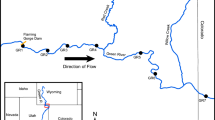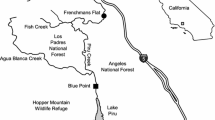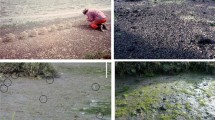Abstract
Species invasions are often associated with large-scale human alteration of ecosystems. One classic example is the increasing dominance of non-native taxa below and above dams on large rivers. These dams substantially alter the physical template of river ecosystems, and exotic taxa often proliferate with potentially large impacts on coexisting taxa and ecosystem processes. Here we document the invasion of New Zealand mud snails (Potamopyrgus antipodarum) in the Colorado River directly below Lake Powell in Glen Canyon, Arizona, USA. We also quantified the magnitude and variability in growth and secondary production of P. antipodarum during 2006–2007 to gain a functional measure of their role in the ecosystem. Snails were first detected in Glen Canyon in 1995, and have since become a dominant component of the invertebrate fauna. Throughout the invasion of P. antipodarum, biomass of other dominant taxa was variable and did not appear to be positively or negatively influenced by the presence of P. antipodarum. Specific growth rates of P. antipodarum were moderate (0.001–0.030 day−1) and strongly related to body size. Mean annual habitat-weighted biomass and production were relatively high (biomass: 4.4 g/m2; secondary production: 13.3 g m−2 year−1) and similar among habitats. Mean monthly biomass and daily secondary production were much more variable, with highest values occurring in autumn. We show that invasion of a productive aquatic consumer to a highly disturbed river ecosystem had little detectable influence on the biomass of other invertebrate taxa. However, additional research will be necessary to fully understand and predict effects of P. antipodarum on coexisting taxa.





Similar content being viewed by others
References
Alonso A, Díez PC (2008) What explains the invading success of the aquatic mud snail Potamopyrgus antipodarum (Hydrobiidae, Mollusca)? Hydrobiologia 614:107–116
Andrews ED (1991) Sediment transport in the Colorado River Basin. In: Marzolf GR (ed) River ecology and dam management. National Academy Press, Washington, DC, pp 54–74
Benenati EP, Shannon JP, Haden GA et al (2002) Monitoring and research: the aquatic food base in the Colorado River, Arizona during 1991–2001. Final report to Grand Canyon Monitoring and Research Center—USGS
Benke AC (1990) A perspective on America’s vanishing streams. J North Am Benthol Soc 9:77–88
Benke AC (1993) Baldi memorial lecture: concepts and patterns of invertebrate production in running waters. Verh Int Ver Limnol 25:15–38
Benke AC, Huryn AD (2006) Secondary productivity of macroinvertebrates. In: Hauer FR, Lamberti GA (eds) Methods in stream ecology. Elsevier, New York, pp 691–710
Blinn DW, Cole GA (1991) Algae and invertebrate biota in the Colorado River: comparison of pre- and post-dam conditions. In: National Research Council (eds) Colorado river ecology and dam management. National Academy of Science Press, Washington, DC, pp 85–104 (238 pp)
Cada CA (2004) Interactions between the invasive New Zealand mud snail, Potamopyrgus antipodarum, baetid mayflies, and fish predators. MS Thesis, Montana State University, Bozeman, MT
Cope NJ, Winterbourn MJ (2004) Competitive interactions between two successful molluscan invaders of freshwaters: an experimental study. Aquat Ecol 38:83–91
Cox TJ, Rutherford JC (2000) Thermal tolerances of two stream invertebrates exposed to diurnally varying temperature. N Z J Marine Freshw Res 34:203–208
Dybdahl MF, Kane SL (2005) Adaptation vs. phenotypic plasticity in the success of a clonal invader. Ecology 86:1592–1601
Elton CS (1958) The ecology of invasions by animals and plants. Methuen, London
Fridley JD, Stachowicz JJ, Naeem S et al (2007) The invasion paradox: reconciling pattern and process in species invasion across spatial scales. Ecology 88:3–17
Grams PE, Schmidt JC, Topping DJ (2007) The rate and pattern of bed incision and bank adjustment on the Colorado River in Glen Canyon downstream from Glen Canyon Dam, 1956–2000. GSA Bull 119:556–575
Haden GA, Blinn DW, Shannon JP, Wilson KP (1999) Driftwood: an alternative habitat for macroinvertebrates in a large desert river. Hydrobiologia 397:179–186
Haden GA, Shannon JP, Wilson KP, Blinn DW (2003) Benthic community structure of the Green and Colorado Rivers through Canyonlands National Park, Utah, USA. Southwest Nat 48:23–25
Hall RO, Tank JL, Dybdahl MF (2003) Exotic snails dominate nitrogen and carbon cycling in a highly productive stream. Front Ecol Environ 1:407–411
Hall RO, Dybdahl MF, VanderLoop MC (2006) Extremely high secondary production of introduced snails in rivers. Ecol Appl 16:1121–1131
Haxton TJ, Findlay CS (2008) Meta-analysis of the impacts of water management on aquatic communities. Can J Fish Aquat Sci 65:437–447
Herbst DB, Bogan MT, Lusardi RA (2008) Low specific conductivity limits growth and survival of the New Zealand mud snail from the upper Owens River, California. West N Am Nat 68:324–333
Howard A, Dolan R (1981) Geomorphology of the Colorado River in Grand Canyon. J Geol 89:269–298
Hunter RD, Lull WW (1976) A comparison of two methods for estimating the weight of inorganic materials in molluscs. Malacol Rev 9:118–120
Huryn AD (1996) An appraisal of the allen paradox in a New Zealand trout stream. Limnol Oceanogr 41:243–252
Huryn AD (1998) Ecosystem-level evidence for top-down and bottom-up control of production in a grassland system. Oecologia 115:173–183
Huryn AD, Wallace JB (1987) Local geomorphology as a determinant of macrofaunal production in a mountain stream. Ecology 68:1932–1942
Kerans BL, Dybdahl MF, Gangloff MM et al (2005) Potamopyrgus antipodarum: distribution, density, and effects on native macroinvertebrate assemblages in the Greater Yellowstone Ecosystem. J North Am Benthol Soc 24:123–138
Loo SE, Mac Nally R, Lake PS (2007) Forecasting New Zealand Mudsnail invasion range: model comparisons using native and invaded ranges. Ecol Appl 17:181–189
Lytle DA, Poff NL (2004) Adaptation to natural flow regimes. Trends Ecol Evol 19:94–100
McKinney T, Speak DW, Rogers RS et al (2001) Rainbow trout in a regulated river below Glen Canyon Dam, Arizona following increased minimum flows and reduced discharge variability. N Am J Fish Manage 21:216–222
Morin A, Mousseau TA, Roff DA (1987) Accuracy and precision of secondary production estimates. Limnol Oceanogr 32:1342–1352
Naeem S, Knops JMH, Tilman D et al (2000) Plant diversity increases resistance to invasion in the absence of covarying extrinsic factors. Oikos 91:97–108
Nilsson C, Reidy CA, Dynesius M et al (2005) Fragmentation and flow regulation of the world’s large river systems. Science 308:405–408
Oberlin GE, Shannon JP, Blinn DW (1999) Watershed influence on the macroinvertebrate fauna of ten major tributaries of the Colorado River through Grand Canyon, Arizona. Southwest Nat 44:17–30
Olden JD, Naiman RJ (2010) Incorporating thermal regimes into environmental flows assessments: modifying dam operations to restore freshwater ecosystem integrity. Freshw Biol 55:86–107
Olden JD, Poff NL, Bestgen KR (2006) Life-history strategies predict fish invasions and extirpations in the Colorado River basin. Ecol Monogr 76:25–40
Poff NL, Allan JD, Bain MB et al (1997) The natural flow regime. Bioscience 47:769–784
Poff NL, Olden JD, Merritt DM et al (2007) Homogenization of regional river dynamics by dams and global biodiversity implications. Proc Natl Acad Sci USA 104:5732–5737
Riley LA, Dybdahl MF, Hall RO (2008) Invasive species impact: asymmetric interactions between invasive and endemic freshwater snails. J North Am Benthol Soc 27:509–520
Rosenberg DM, McCully P, Pringle CM (2000) Global-scale effects of hydrological alterations: introduction. Bioscience 50:746–751
Schrieber ESG, Lake PS, Quinn GP (2002) Facilitation of native stream fauna by an invading species? Experimental investigations of the interaction of the snail Potamopyrgus antipodarum (Hydrobiidae) with native benthic fauna. Biol Invasions 4:317–325
Schrieber ESG, Quinn GP, Lake PS (2003) Distribution of an alien aquatic snail in relation to flow variability, human activities and water quality. Freshw Biol 48:951–961
Shannon JP, Blinn DW, Benenati PL, Wilson KP (1996) Organic drift in a regulated river. Can J Fish Aquat Sci 53:1360–1369
Shannon JP, Blinn DW, McKinney T et al (2001) Aquatic food base response to the 1996 test flood below Glen Canyon Dam, Colorado River, Arizona. Ecol Appl 11:672–685
Shannon JP, Benenati EP, Kloeppel H et al (2003) Monitoring the aquatic food base in the Colorado River, Arizona during June and October 2002. Annual report to Grand Canyon Monitoring and Research Center—USGS
Shea K, Chesson P (2002) Community ecology theory as a framework for biological invasions. Trends Ecol Evol 17:170–176
Stevens LE, Shannon JP, Blinn DW (1997) Colorado River benthic ecology in Grand Canyon, Arizona, USA: dam, tributary and geomorphological influences. Regul Rivers Res Manage 13:129–149
Strayer DL, Malcom HM (2007) Effects of zebra mussels (Dreissena polymorpha) on native bivalves: the beginning of the end or the end of the beginning? J North Am Benthol Soc 26:111–122
Strayer DL, Smith LC (1996) Relationships between zebra mussels (Dreissena polymorpha) and unionid clams during the early stages of the zebra mussel invasion of the Hudson River. Freshw Biol 36:771–779
Strayer DL, Caraco NF, Cole JJ et al (1999) Transformation of freshwater ecosystems by bivalves: a case study of zebra mussels in the Hudson River. Bioscience 49:19–27
Sublette JE, Stevens LE, Shannon JP (1998) Chironomidae (Diptera) of the Colorado River, Grand Canyon, Arizona, USA, I: systematics and ecology. Great Basin Nat 58:97–146
Syvitski JPM, Vorosmarty CJ, Kettner AJ et al (2005) Impact of humans on the flux of terrestrial sediment to the global coastal ocean. Science 308:376–380
Topping DJ, Schmidt JC Vierra LE (2003) Computation and analysis of the instantaneous-discharge record for the Colorado River at Lees Ferry, Arizona—May 8, 1921, through September 30, 2000. Professional Paper 1677, USGS
Vannote RL, Sweeney BW (1980) Geographic analysis of thermal equilibria: a conceptual model for evaluating the effect of natural and modified thermal regimes on aquatic insect communities. Am Nat 115:667–695
Vinson MR (2001) Long-term dynamics of an invertebrate assemblage downstream from a large dam. Ecol Appl 11:711–730
Vinson MR, Baker MA (2008) Poor growth of rainbow trout fed New Zealand mud snails Potamopyrgus antipodarum. N Am J Fish Manage 28:701–709
Ward JV, Zimmermann HJ, Cline LD (1986) Lotic zoobenthos of the Colorado system. In: Davies BR, Walker KF (eds) The ecology of river systems. Springer, Berlin
WCD (World Commission on Dams) (2000) Dams and development: a new framework for decision making. Earthscan Publications, London
Webb RH, Wegner DL, Andrews ED, Valdez RA, Patten DT (1999) Downstream effects of Glen Canyon dam on the Colorado River in Grand Canyon: a review. In: The controlled flood in Grand Canyon. Geophysical Monograph Series 110, pp 1–21
Winterbourn MJ (1969) Water temperature as a factor limiting the distribution of Potamopyrgus antipodarum (Gastropoda-Prosobranchia) in the New Zealand thermal regimes. N Z J Mar Freshw Res 3:453–458
Wu J, Huang J, Han Z et al (2004) The Three Gorges Dam: an ecological perspective. Front Ecol Environ 2:241–248
Acknowledgments
The United States Geological Survey supported this research through cooperative agreement 05WRAG0055 to ROH and ERM. We thank Julie Alexander, Matthew Andersen, Kiza Gates, James Junker, Billie Kerans, and David Walters for useful and constructive comments on earlier drafts. We also thank Daniel Simberloff and the anonymous reviewers for constructive comments that helped improve the manuscript.
Author information
Authors and Affiliations
Corresponding author
Rights and permissions
About this article
Cite this article
Cross, W.F., Rosi-Marshall, E.J., Behn, K.E. et al. Invasion and production of New Zealand mud snails in the Colorado River, Glen Canyon. Biol Invasions 12, 3033–3043 (2010). https://doi.org/10.1007/s10530-010-9694-y
Received:
Accepted:
Published:
Issue Date:
DOI: https://doi.org/10.1007/s10530-010-9694-y




